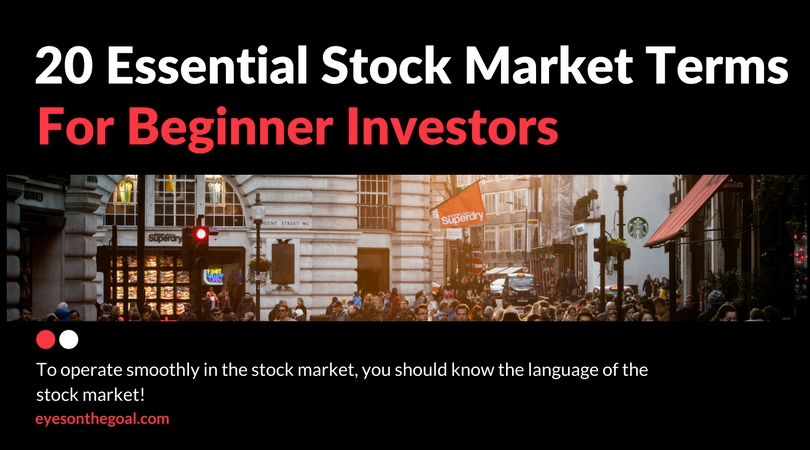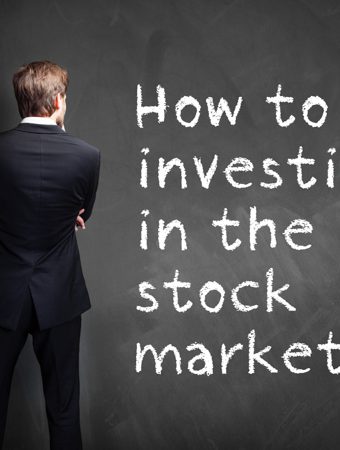This is post #16 from the 30 Day Personal Finance Challenge: Boost Your Financial Health with a Daily Tip!
Congratulations! Now that you have opened yourself a brokerage account, you officially entered the stock market world! To operate smoothly in this world, you should know the language of the stock market.
In today’s post you will find the most common terms and concepts:
Exchange: a place in which different investments are traded. Examples: New York Stock Exchange (NYSE), the Nasdaq, the London Stock Exchange.
Stock: a share in the ownership of a company. Stock represents a claim on the company’s assets and earnings. As you acquire more stock, your ownership stake in the company becomes greater. Also known as shares or equity.
Blue chip: a well-established and financially sound company. Blue chips generally sell high-quality, widely accepted products and services. Blue chip companies are known to operate profitably in the face of adverse economic conditions, which helps to contribute to their long record of stable and reliable growth. The term comes from the game of poker, where the blue chip is the most valuable.
Dividend: a payment made by a corporation to its shareholders, usually as a distribution of profits. When a corporation earns a profit or surplus, it can re-invest it in the business (called retained earnings), and pay a fraction of the profit as a dividend to shareholders.
Stock index: also market index or stock market index is a measurement of the value of a section of the stock market. It is a benchmark which is used as a reference marker for traders and portfolio managers. A 10% may sound good, but if the market index returned 12%, then you didn’t do very well since you could have just invested in an index fund and saved time by not trading frequently.
Examples of indexes:
– Dow Jones – an important index many people watch to get an indication of how well the overall stock market is performing
– S&P 500 – the Standard & Poor’s 500 is composed of 500 large companies having common stock listed on the New York Stock Exchange (NYSE) or Nasdaq.
– Nasdaq – the Nasdaq Composite is based on the 3000+ equities traded on the Nasdaq exchange
– MSCI World – stock market index of 1,654 ‘world’ stocks
ETF: an exchange-traded fund designed to follow certain preset rules so that the fund can track specified basket of underlying investments. Those rules may include tracking prominent indexes like the S&P 500 or the Dow Jones Industrial Average.
The lack of active management generally gives the advantage of lower fees. Typically expense ratios of range from 0.10% to 0.70%.
Compound interest: simply put, this is interest on interest. It’s a key element in growing your money. It is the result of reinvesting interest, rather than paying it out, so that interest in the next period is then earned on the principal sum plus previously accumulated interest.
Price/earning ratio: the p/e ratio is the ratio for valuing a company that measures its current share price relative to its per-share earnings. It shows how much investors are willing to pay per dollar of earnings. Historically, the average P/E ratio in the market has been around 15-25. This fluctuates significantly depending on economic conditions.
Market Cap: also known as market capitalization is the total market value of all of a company’s outstanding shares. It’s the price of a company but doesn’t always reflect the value of the business.
Bear market: a market in which prices fall and widespread pessimism causes the stock market’s downward spiral.
Bull market: a market in which share prices are rising, encouraging buying.
Actively managed fund: uses either a single manager, co-managers, or a team of managers to attempt to outperform the market and produce better returns than those of passively managed index funds.
Management fee: a charge levied by an investment manager for managing an investment fund. It is intended to compensate the managers for their time and expertise for selecting stocks and managing the portfolio. Management fees can range from as low as 0.10% to more than 2%.
Passively managed fund: also known as index fund – the portfolio mirror the components of a market index. It simply follows a market index. It does not have a management team making investment decisions.
Averaging down: this is when an investor buys more of a stock as the price goes down. Thus your average purchase price decreases.
Day trading: the practice of buying and selling within the same trading day, before the close of the markets on that day. This is the opposite of having a long-term portfolio. Traders who participate in day trading are often called active traders or day traders.
Portfolio: a collection of investments owned by an investor. You can have as little as one stock in a portfolio to an infinite amount of stocks.
Initial Public Offering (IPO): the first sale or offering of a stock by a company to the public, rather than just being owned by private or inside investors.
Volatility: this refers to the price movements of a stock or the stock market as a whole. Highly volatile stocks are ones with extreme daily up and down movements and wide intraday trading ranges.
Quote: the price of a stock as quoted on an exchange.
Hey, if you reached so far, you are ready for your investing adventure! Don’t worry, it’s just the beginning. Everything will fall into place eventually. The best time to start investing is 20 years ago. The second best time is TODAY!
Welcome to the stock market world! And as you are anyways here, consider subscribing in the form at the bottom of the page.



